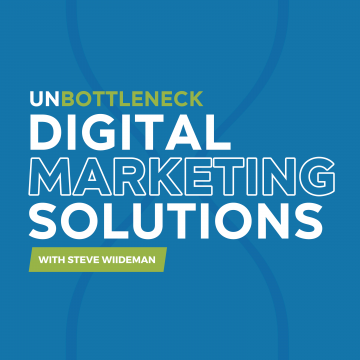Podcast: Play in new window | Download
In this episode of the Unbottleneck Podcast, we’re in for a very special treat as Steve Wiideman is joined by acclaimed digital marketing guru, Andy Crestodina, for an eye-opening conversation about understanding key Data Metrics, Goal Tracking, KPI, A-B Testing and more!
About Our Guest: Andy Crestodina
The multi-talented Andy Crestodina is co-founder and chief marketing officer of Orbit Media, an award-winning digital agency in Chicago specializing in web design and development. In 20 years, he has provided digital marketing strategies to over 1,000 companies and still counting.
He is also an author, speaker, mentor and lecturer with a passion for all things digital marketing. He has written hundreds of articles on content strategy, search engine optimization, social media, and analytics and continues to unlock new areas of digital knowledge with his book, “Content Chemistry.”
Sponsored by Ryte
Featured in this episode:
- Critical Metrics: Traffic, Conversion Rates and more
- Identifying your Key Performance Indicators (KPIs)
- Bringing Teaching into Your Marketing Efforts
- A/B Testing Essentials
The Most Important Digital Marketing Metrics
Marketing is data-driven. There are many metrics available to measure different areas of performance, but are you paying attention to the metrics that really matter?
In digital marketing the two most important metrics are traffic and conversion rates. No matter what your business is, your goals will always be centered around (1) attracting quality visitors to your website and (2) turning them into leads and customers. However, the true measure of success is not in what you see, but what you don’t see.
There are metrics that are more visible than others, such as social media followers or search engine rankings, but those metrics are not related to your business’s success. The metrics that will truly measure your success will not be visible to the public, such as sales closing rates and net promoter scores. Even though these types of metrics might take a little more effort to find, they are most important to achieving your bottom line.
In simple terms, the more visible the metric is, the more irrelevant it is. Instead, pay attention to the data that is less obvious because it gives you a better picture of how your business is performing.
How to Identify Your Business KPIs
KPIs, or Key Performance Indicators, are valuable and quantifiable measures of performance that are used to assess how your business is performing against its objectives.
While KPIs correlate with success, it is not a sole indicator of success. In fact, digital marketing KPIs are typically tracked using a software tool where results can fluctuate regularly. That’s why it’s important to not obsess over a single one.
Many businesses will rely on best practices to measure results, however, it’s not necessary if you have your own data. Every business is different so you have to do what’s appropriate for your context, content, audience and platform. You can do this by using your data, to create a list of hypotheses that you can test and measure over time in order to perfect your business model.
As a business owner, you can hold your team accountable for results by assigning KPIs in order to measure important milestones on the way to success.
Here are some examples of KPIs you can assign to your SEO team:
- Web – Accessibility, Security, Privacy, Mobile-Friendliness
- Content – Keyword Ranking, Page Performance
- Link Building – Quality of Links
Pro-Tip: For content marketing efforts, “time on page” is a great KPI that directly correlates with search engine rankings.
Make it Plain: Effective Marketing Communication
If you are a marketing practitioner, it’s not always easy to translate data to clients and/or business owners. While clients may not speak the language of marketing, they will always speak the language of results. Therefore, you must make it a priority to connect with your clients by breaking down complex data in a simple way.
The best marketers are teachers! Rather than trying to bring clients to your marketing level, meet them where they are by using their language to communicate terminology, methods and results.
Here are some tips that will help you keep it simple in order connect more with your clients and/or audience:
- Be clear, not clever
- Don’t use big words
- Speak like they would speak
Remember – communication is not what you say, but what they hear.
From the Bottom Up: A/B Testing
A/B testing, or split testing, is the practice of creating two versions of a web page to determine which one performs better.
According to Andy, the best method to optimize with A/B testing is by starting from the bottom up – your end goal. If your goal is to have a visitor fill out a contact form, then start testing on the contact page. From the contact page, test the “Call-to-Action” page, then the home page.
It will be important to test these components over time to determine if they are helping or hindering your conversions. If you find that changing certain elements (i.e language, color, or placement) is having a positive influence on user behavior, then keep them!
On the other hand, if these elements are having a negative influence on user behavior, then keep testing until you get the results you desire.
Pro-Tip: There is no need to do an A/B test for every component of your website. If you already know something on the web page is broken, just fix it.
Keep up with the data-driven SEO and digital marketing strategies. Follow Steve on LinkedIn!




